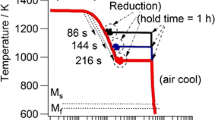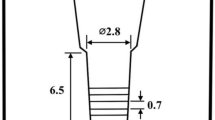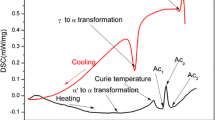Abstract
A new steel with high Cr and low W, Mo contents for forged cold work roll was designed based on the composition system of traditional high-speed steel roll. The Fe-C isopleths of the steel and the mass fraction of equilibrium phases versus temperature were calculated by Thermo-Calc, and the effects of different alloying elements (W, Mo, Cr, V) on austenite, ferrite, and carbides (MC, M6C, M7C3, M23C6) were also established to optimize the composition and structure. The designed and optimized specimens were both quenched at 1100 °C and then tempered twice at 560 °C. The hardness and wear resistance of the samples were measured. The microstructures of quenched tempered and forged specimens were studied. The results show that ferrite crystallization, peritectic reaction, austenite crystallization, and the precipitation of MC, M6C, M7C3, M23C6 occur during equilibrium solidification process. The alloying elements W, Mo mainly affect the precipitation of M6C, while Cr affects the precipitated region and mass fraction of M7C3. Higher V content widens the high-temperature region of the peritectic reaction and results in a large amount of MC precipitation. The optimized composition (wt.%) for cold work roll steel is 1.30-1.35%C, 9-10%Cr, 2.5-3.0%Mo, 0.5-1.0%W, 2.5-3.0%V, 0.5-0.6%Mn, 0.5-0.6%Si. The hardness of the steel after quenching and tempering is 60.8 HRC and weight loss after 120 min is 6.2 mg. This meets the requirement of hardness and wear resistance requirements for cold work roll. The ledeburite in the optimized steel disappears after forging and the carbide network break into a large amount of tiny blocky ones dispersed in the matrix without cracks, which shows a good forgeability of the steel and rationality of the optimized composition.









Similar content being viewed by others
References
A.K. Ray, K.K. Mishra, G. Das, and P.N. Chaudhary, Life of Rolls in a Cold Rolling Mill in a Steel Plant—Operation Versus Manufacture, Eng. Fail. Anal., 2000, 7, p 55–67
H.C. Li, Z.Y. Jiang, A.K. Tieu, W.H. Sun, and D.B. Wei, Experimental Study on Wear and Friction of Work Roll Material with 4%Cr and Added Ti in Cold Rolling, Wear, 2011, 271, p 2500–2511
P. Montmitonnet, Hot and Cold Strip Rolling Processes, Comput. Method Appl. Mech. Eng., 2006, 195, p 6604–6625
C.R.F. Azevedo and N.J. Belotti, Failure Analysis of Forged and Induction Hardened Steel Cold Work Rolls, Eng. Fail. Anal., 2004, 11, p 951–966
S. Iwadoh and T. Mori, Effect of Work Roll Materials and Progress of Manufacturing Technology on Cold Rolling and Future Developments in Japan, ISIJ Int., 1992, 32, p 1131–1140
S. Wang and D.Q. Liu, Development of the Steel for Forged Cold Work Roll, Met. Form., 2013, 5, p 70–72 ((in Chinese))
G. Wang, X. Liu, and J. Wang, Roll and Technique Coolant Lubrication for Cold Tandem Rolling, Steel Roll., 2003, 6, p 42–46
S. Shimizu, K. Aoki, M. Kobayashi, T. Saito, Y. Yamada, and F. Kosumi, A Ti-enhanced Cold Rolling Work Roll with Self-Generating Optimal Roughness Characteristics, ISIJ Int., 1992, 32, p 1238–1243
V. Vitry, S. Nardone, J.-P. Breyer, M. Sinnaeve, and F. Delaunois, Microstructure of Two Centrifugal Cast High Speed Steels for Hot Strip Mills applications, Mater. Des., 2012, 34, p 372–378
K.C. Hwang, S. Lee, and H.C. Lee, Effects of Alloying Elements on Microstructure and Fracture Properties of Cast High Speed Steel Rolls. Part I: Microstructure Analysis, Mater. Sci. Eng. A, 1998, 254, p 282–295
X.D. Zhang, W. Liu, D.L. Sun, and Y.G. Li, The Transformation of Carbides During Austenization and Its Effect on the Wear Resistance of High Speed Steel Rolls, Metall. Mater. Trans. A, 2007, 38, p 499–505
S.Z. Wei, J.H. Zhu, L.J. Xu, and R. Long, Effects of Carbon on Microstructures and Properties of High Vanadium High-Speed Steel, Mater. Des., 2006, 27, p 58–63
H.G. Fu, Y.H. Qu, J.D. Xing, X.H. Zhi, Z.Q. Jiang, M.W. Li, and Y. Zhang, Investigations on Heat Treatment of a High-Speed Steel Roll, J. Mater. Eng. Perform., 2008, 17, p 535–542
Y.K. Deng, J.R. Chen, and S.Z. Wang, High Speed Tool Steels, The Metallurgical Industry Press, Beijing, 2002
J. Guo, L.G. Liu, Q. Li, Y.L. Sun, Y.K. Gao, X.J. Ren, and Q.X. Yang, Characterization on Carbide of a Novel Steel for Cold Work Roll During Solidification Process, Mater. Charact., 2013, 79, p 100–109
Acknowledgments
The author would like to express their gratitude for projects supported by National Natural Science Foundation of China (51271163) and National Natural Science Foundation of China (51471148).
Author information
Authors and Affiliations
Corresponding author
Rights and permissions
About this article
Cite this article
Guo, J., Liao, B., Liu, L. et al. Composition Optimization and Experimental Characterization of a Novel Steel Based on CALPHAD. J. of Materi Eng and Perform 24, 2099–2107 (2015). https://doi.org/10.1007/s11665-015-1457-6
Received:
Revised:
Published:
Issue Date:
DOI: https://doi.org/10.1007/s11665-015-1457-6




